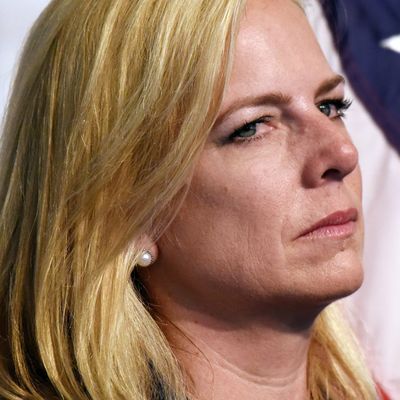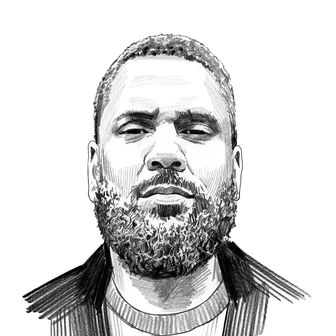
Kirstjen Nielsen resigned on Sunday after President Trump asked her to. “It is the right time for me to step aside,” the outgoing secretary of homeland security said. She will remain at the White House until Wednesday to ensure an “orderly transition” of power. Chaos marked her tenure. It seems unlikely that order would grace her now. The transition has already been rocky. Trump announced Nielsen’s replacement, Kevin McAleenan, in a tweet. But his promotion means that Claire McGrady, the DHS under secretary for management and next in line to run the department, has to be fired. The New York Times reports that McGrady has no immediate plans to leave. Nielsen does not have a deputy secretary, who would otherwise take her place.
Nielsen, meanwhile, expects a hostile reception after she leaves. Fear of life after Trump is part of what kept her from quitting the administration sooner, according to the Times’ Maggie Haberman. “[She] was aware how awful life would … be for her on the outside after defending his policies,” Haberman tweeted. She has already had a foretaste: Activists with the Democratic Socialists of America drove her from a restaurant last summer. “If kids don’t eat in peace, you don’t eat in peace,” they said, citing her implementation of Trump’s child-separation policy. “Shame!”
But while discord may be fueling her exit, Nielsen was never a foil to the president. The substantive difference is that she limited her cruelty to what was permitted by law. Trump pressured her to go further, often demanding in early morning phone calls that she block all migrants from seeking asylum at the United States–Mexico border — which is illegal. More telling was their overlap. Both Trump and Nielsen were unabashed liars. Both shared an immigration agenda that was white nationalist in all but open self-identification. Key to this function — white-label white nationalism — was a receptive public, so both were also adept at placing white nationalists on moral par with their enemies. Trump said there were “fine people on both sides” of a white supremacist rally in Charlottesville, Virginia, in 2017. Nielsen added that the rally was not a matter of “one side is right, one side is wrong. Anybody that is advocating violence, we need to work to mitigate.”
Among Trump’s hallmarks as a statesman has been his ability to relativize violent behavior among bigots. He pursues white nationalist policies and parrots white nationalist talking points while insisting that white nationalist violence is both condemnable and unexceptional. This latter point, that white nationalist violence is no worse than any other kind of violence, is crucial. It argues a point that, under most circumstances, would be uncontroversial: that violence is a poor way to resolve conflict, no matter who commits it. And this grants him plausible deniability when critics call him a bigot — at least to those who assign bigotry according to who embraces the label.
This argument elides that fact that Trump is actually fine with some kinds of violence, and has a clear rubric regarding when it is acceptable and against whom. Protesters at his rallies, criminal suspects, and undocumented immigrants crossing the U.S.-Mexico border fit the bill. White nationalists never have. On the contrary, the president makes special efforts to condemn violence against them and equate them with their detractors. “[You] had a group on one side that was bad,” he said of the Charlottesville clashes. “And you had a group on the other side that was also very violent.” Rather than be vilified as a singular pox, white nationalists find themselves with a president who shares many of their policy goals and believes they are no worse than those who greet them in kind. This is especially insidious in cases like Charlottesville, where their violence was demonstrably worse than the opposition: One of them killed a woman, 32-year-old Heather Heyer, by running her over with a car.
Kirstjen Nielsen is aware of this. During a panel at the Aspen Institute in July, NBC News’s Peter Alexander asked her, “Does [it] make your job harder when the president says things that, at least in those [white nationalist] communities, are viewed as, ‘He’s got our back?’” It should be noted that white nationalists did not need more hints than they already had. Trump’s rhetoric and policies targeting Muslims and Mexicans were enough to secure endorsements from David Duke and Richard Spencer. But his Charlottesville comments made explicit what had previously gone unsaid. Trump had already cut grant funding to organizations that counter white extremism. Even if Nielsen believed her own absurd claims that he prioritized such efforts using law enforcement, she had the whole year after Charlottesville to realize that few others did — including the white nationalists themselves. “We [at DHS] have to work with everyone to help communities understand, what are the warning signs?” she said. “And that’s no matter who it is. I think what’s important about that conversation is, it’s not that one side is right, one side is wrong.”
The notion that white nationalists are neither right nor wrong will surely be news to some. And the idea that violence in general is the problem — instead of the context in which it is deployed — should give pause to an administration that celebrates it so openly when it furthers the president’s agenda. But Trump’s hypocrisy is perhaps the least worrisome element here. That his officials parrot similar white nationalist talking points and implement them as policy is more troubling. Nielsen showed Americans what happens when the nation’s top immigration official believes that the violence this worldview produces is unremarkable. She became a willing vessel for it, and it still was not brutal enough for Trump. In her wake, it only stands to get worse.






























